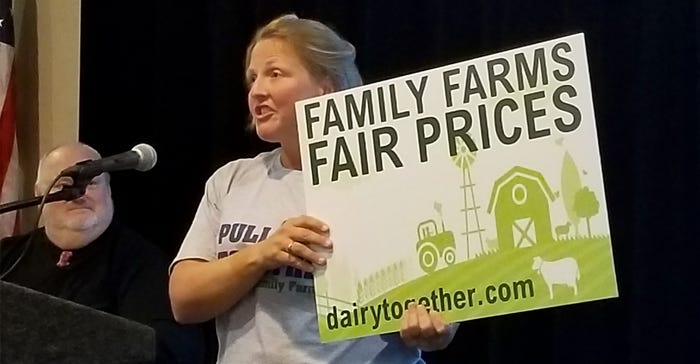August 15, 2018

DAIRY TOGETHER: Deb Jakubek of the Wisconsin Farmers Union holds up a sign promoting the group’s Dairy Together campaign.Paul Post
By Paul Post
Dairy producers nationwide have been dealing with fourth straight years of low milk prices that have forced many farms out of business and left countless others struggling to survive.
In a search for short- and long-term answers, more than 350 industry representatives, from Maine to California, about half of them farmers, gathered Monday in Albany, N.Y., for a dairy summit hosted by the Vermont-based Agri-Mark Cooperative. Attendees came from nearly a dozen states, including a large busload of people from Wisconsin and Michigan, plus Canada.
"We've got to find some action that happens right away," said Bob Wellington, Agri-Mark senior vice president for economics, communications and legislative affairs. "All farmers are suffering right now, no matter the size or location."
There's widespread agreement on root causes of the problem: too much milk and shrinking demand. The challenge is getting farmers and industry leaders to reach consensus on a viable solution that can be presented to state and federal policymakers whose approval is required for meaningful change.
"If the industry can come up with a plan that's clear about what it's intended to do and will benefit the public interest, Congress will respond to that," said attorney Daniel Smith, a conference panelist.
Following a morning-long review of past and current supply programs, attendees were presented with 12 different suggestions for improving producers' bottom line. These are found at the website dairyproposals2018.com. People are encouraged to review and provide feedback on each proposal.
"We have a working group that will look at it," Wellington said. "Then we can start to coalesce around one or two proposals. We can do amazing things if farmers all put their mind to it. We've done it on various programs.
"We have to make it work for processors because they buy our milk. We have to make it work for consumers. But at the end of the day, it's got to return a fair price to farmers."
An idea floated by John Wilson, of Dairy Farmers of America, could provide the quickest returns. He suggests using some of the $12 billion in emergency aid President Donald Trump has pledged for farmers to fund a diversion program that would take milk out of the system. For example, farms might be paid $5 per cwt in production they cut.
"That would change prices right away," Wellington said. "All we need is a 1% or 2 % cut in production and you can raise prices at least 10%, maybe 20%. So, there may be some immediate action. Then we have to start pursuing this as an industry."
Some presenters called for a base excess plan that penalizes producers for exceeding predetermined levels. Others cited the need for voluntary cutbacks, coordinated by cooperatives. But attorney panelists said this might trigger class-action lawsuits based on anti-trust laws.
Mark McAfee, executive director of California Dairy Campaign, said it's time for the U.S. to adopt a quota-based system similar to Canada's, which would eliminate volatility and stabilize prices.
"Every region of the country has different prices and different supply needs," he said. "Every region should be represented by regional farmer boards that say: this is the price, this is the supply we need in this area. Exercise import-export discipline and with that we'll have a long-term solution to this problem.
"We have to have a new model," he said. "People in this room are starving. How can we feed the world if we can't feed ourselves?"
Paul Post writes from eastern New York.
You May Also Like




